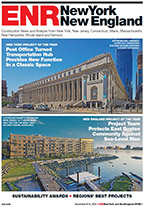New York State Flood-Recovery Projects Move Forward








In June 2013, New York Gov. Andrew Cuomo (D) established the Governor's Office of Storm Recovery to aid communities—outside New York City—affected by 2012's Superstorm Sandy and 2011's Hurricane Irene and Tropical Storm Lee. Since then, GOSR has guided the rebuilding of nearly 10,000 houses, provided $20.8 million in small-business grants and facilitated the proposal of 600 resilience projects through the New York Rising Community Reconstruction Program, according to a recent GOSR report, called "New York Rising: 2012-2014."
"There is a pipeline of projects coming out of planning and going into design and construction," says Niek Veraart, engineer Louis Berger's vice president of environmental planning. LB worked on the report with Perkins Eastman Architects and BFJ Planning.
"The hallmark of the New York Rising programs is a 're-imagining' of disaster recovery, from solely a top-down governmental approach to one that is also bottom up, driven by individuals and communities directly affected," says the 44-page report released on Oct. 29, two years after Superstorm Sandy.
The report updates plans for more-resilient housing, infrastructure, small businesses and communities that are outside New York City. New York Rising provides a framework for municipalities to collaborate on innovative solutions for flooding, including joint green infrastructure projects, says Eric C.Y. Fang, associate principal with Perkins Eastman Architects.
Eligible communities may receive up to $25 million for revitalization efforts. Communities have until December 2019 to complete their projects, which are financed by the U.S. Dept. of Housing and Urban Development's Community Development Block Grant-Disaster Recovery program. Last month, HUD announced the final $600 million of the more than $4.4 billion worth of CDBG-DR grants for communities outside New York City.
Beyond the CDBG-DR projects, GOSR has identified $15.74 billion in "outstanding" state repair and recovery projects not currently funded by federal programs.





